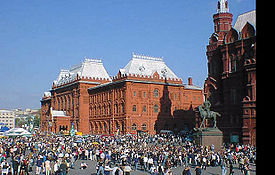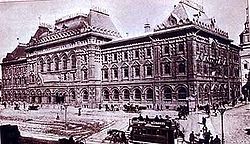
Moscow City Hall
Encyclopedia

State Historical Museum
The State Historical Museum of Russia is a museum of Russian history wedged between Red Square and Manege Square in Moscow. Its exhibitions range from relics of the prehistoric tribes inhabiting present-day Russia, through priceless artworks acquired by members of the Romanov dynasty...
and notable in the history of architecture
History of architecture
The history of architecture traces the changes in architecture through various traditions, regions, overarching stylistic trends, and dates.-Neolithic architecture:Neolithic architecture is the architecture of the Neolithic period...
as a unique hybrid of the Russian Revival
Russian Revival
The Russian Revival style is the generic term for a number of different movements within Russian architecture that arose in second quarter of the 19th century and was an eclectic melding of pre-Peterine Russian architecture and elements of Byzantine architecture.The Russian Revival style arose...
and Neo-Renaissance
Neo-Renaissance
Renaissance Revival is an all-encompassing designation that covers many 19th century architectural revival styles which were neither Grecian nor Gothic but which instead drew inspiration from a wide range of classicizing Italian modes...
styles. During Soviet
Soviet Union
The Soviet Union , officially the Union of Soviet Socialist Republics , was a constitutionally socialist state that existed in Eurasia between 1922 and 1991....
times it served as the V. I. Lenin
Vladimir Lenin
Vladimir Ilyich Lenin was a Russian Marxist revolutionary and communist politician who led the October Revolution of 1917. As leader of the Bolsheviks, he headed the Soviet state during its initial years , as it fought to establish control of Russia in the Russian Civil War and worked to create a...
Museum.
History
In contrast to other European capitals, MoscowMoscow
Moscow is the capital, the most populous city, and the most populous federal subject of Russia. The city is a major political, economic, cultural, scientific, religious, financial, educational, and transportation centre of Russia and the continent...
had no city hall
City hall
In local government, a city hall, town hall or a municipal building or civic centre, is the chief administrative building of a city...
until the establishment of zemstvo
Zemstvo
Zemstvo was a form of local government that was instituted during the great liberal reforms performed in Imperial Russia by Alexander II of Russia. The idea of the zemstvo was elaborated by Nikolay Milyutin, and the first zemstvo laws were put into effect in 1864...
in the late 19th century. In the 1880s, when Red Square
Red Square
Red Square is a city square in Moscow, Russia. The square separates the Kremlin, the former royal citadel and currently the official residence of the President of Russia, from a historic merchant quarter known as Kitai-gorod...
and the neighbourhood were being overhauled in the Neo-Russian style, the Moscow City Duma decided to commission an impressive building for its headquarters. During the competition that followed in 1887, architect Dmitry Chichagov (1835-94) emerged as the winner.
Building work was begun three years later, with some remains of the early 18th-century Kitai-gorod
Kitai-gorod
Kitay-gorod , earlier also known as Great Posad , is a business district within Moscow, Russia, encircled by mostly-reconstructed medieval walls. It is separated from the Moscow Kremlin by Red Square. It does not constitute a district , as there are no resident voters, thus, municipal elections...
Mint
Mint (coin)
A mint is an industrial facility which manufactures coins for currency.The history of mints correlates closely with the history of coins. One difference is that the history of the mint is usually closely tied to the political situation of an era...
incorporated into the new structure. After the Russian Revolution of 1917
Russian Revolution of 1917
The Russian Revolution is the collective term for a series of revolutions in Russia in 1917, which destroyed the Tsarist autocracy and led to the creation of the Soviet Union. The Tsar was deposed and replaced by a provisional government in the first revolution of February 1917...
, the duma was disbanded and the large building was handed over to the Lenin Museum. As a consequence of this decision, opulent pre-revolutionary halls were either plastered or painted over, either to not to distract the visitor's attention from the personal effects of the deceased Communist leader exhibited there or as a negation of pre-revolutionary bourgeoisie culture.
Following the fall of Communism, the Moscow City Duma was reinstated but preferred to keep its headquarters in a modest building of the former Moscow Soviet on Petrovka Street. The pre-revolutionary city hall is currently employed to exhibit the vast collections of the State Historical Museum.
Architecture

In keeping with their tastes, the building retains the forms of Muscovite antiquity required to prepare a passerby for the medieval solemnity of the Kremlin and Red Square. The roof is reminiscent of the Terem Palace
Terem Palace
Terem Palace or Teremnoy Palace is a historical building in the Moscow Kremlin, Russia, which used to be the main residence of the Russian tsars in the 17th century. Its name is derived from the Greek word τερεμνον...
, an early 17th-century structure which may be found in the nearby Kremlin, whereas the exuberant form of ornamentation used in abundance for the façade suggests certain motifs from the adjacent State Historical Museum and the Iberian Gate.
Despite all these references to the Russian Middle Ages, the principal hall and other interiors used to be liberally seasoned with Italianate elements. The strictly symmetrical ground plan of Chichagov's building is also typical of Western architecture, as is the ornamental monotony of the façade, which fronts the Hotel Moskva
Hotel Moskva (Moscow)
The Hotel Moskva name has been used for two identical buildings on the same spot in Moscow, Russia located near Red Square in close proximity to the old City Hall. The first Hotel Moskva was originally constructed from 1932 until 1938, it opened as a hotel in December 1935...
, sprawling on the opposite side of Revolution Square.

